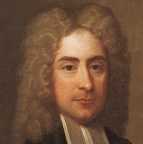Charles Cobbe
| The Most Reverend Charles Cobbe DD | |
|---|---|
|
Archbishop of Dublin and Primate of Ireland | |
 | |
| Archdiocese | Dublin |
| Appointed | 4 March 1743 |
| Term ended | 14 April 1765 |
| Predecessor | John Hoadly |
| Successor | William Carmichael |
| Personal details | |
| Born | 1687 |
| Died |
14 April 1765 St. Sepulchre's, Dublin |
| Buried | Dunabate |
| Nationality | British |
| Denomination | Anglican |
| Spouse | Dorothea Levinge |
| Alma mater | Trinity College, Oxford |
Charles Cobbe (Swarraton, 1686–1765) was Archbishop of Dublin from 1743 to 1765, and as such was Primate of Ireland.
Life
He was the second son of Thomas Cobbe, Receiver General for County Southampton, and Veriana (née Chaloner) Cobbe of Swarraton, Winchester in Hampshire, England.[1][2]
Charles Cobbe's maternal grandfather James Chaloner had briefly been Governor of the Isle of Man in 1658–1660, before committing suicide by poison at the approach of Lord Fairfax's soldiers. In some sources Charles father Thomas Cobbe is also given the title Governor of the Isle of Man.[3][4] Charles's older brother was Colonel Richard Chaloner Cobbe.[5][6][7]
In 1730, Charles married Dorothea Levinge, widow of Sir John Rawdon Bt, of Moira, County Down. Dorothea had two sons by Sir John: John, later Earl of Moira; and Arthur Rawdon. Dorothea bore two more sons by Charles Cobbe: Charles (1731–1750); and Thomas (1733–1814).
Charles was founder[8] of the prominent Cobbe family in Ireland, and built the ancestral home Newbridge Estate outside Dublin between 1747 and 1752.
He died at St. Sepulchre's, Dublin, on 14 April 1765, and was buried at Dunabate. [9]
Ecclesiastical career
Cobbe arrived in Ireland in August 1717 as chaplain to his cousin Charles Paulet, 2nd Duke of Bolton, Lord Lieutenant of Ireland. By January the following year he was appointed Dean of Ardagh. In 1720, he was appointed to the Bishopric of Killala. By 1726 he was translated to the See of Dromore, and in 1731 he was promoted to the Bishopric of Kildare and the Deanery of Christ Church. He held this position until 10 March 1743 when he was enthroned as Archbishop of Dublin,[9] bringing him to fourth in precedence in the government of Ireland.
Notes
- ↑ Clerics & connoisseurs: the Rev. Matthew Pilkington, the Cobbe ...; Alastair Laing, Nicholas Turner; English Heritage – 2001 "1750 Portrait of Charles Cobbe, as Bishop of Kildare, later Archbishop of Dublin (1686–1765) Oil on canvas, ... 1730 and had two sons, Charles and Thomas, the latter born in 1733, when Dorothea died, presumably in childbirth."
- ↑ Country Life 2001 "The story begins with Charles Cobbe 1686–1765 ... In 1730, they were married, but only three years later Dorothea died, perhaps as a result of giving birth to her second Cobbe son, Thomas."
- ↑ Publications of the Manx Society; Volume 24 1877 "James Chaloner was appointed Governor in 1658, and continued so until 1660. Lord Fairfax held the Island until the Restoration, 28th May, 1660. The death of Oliver Cromwell, on the 3d September 1658, was a great blow to the Commonwealth ..."
- ↑ The Concise Encyclopedia of the Revolutions and Wars of England, ... – Page 103; Stephen C. Manganiello – 2004 "In 1652, Parliament granted Lord Fairfax, his wife's cousin, the Isle of Man. On August 17, 1652, Chaloner was appointed one of the three commissioners to settle Fairfax's affairs on the island. Later, he wrote the Short Treatise of the... Wood says that in March or April, 1660, messengers were sent from the Superior Power to take James Chaloner into custody, and to secure his castle for the use of His Majesty; "but he having received timely notice of their coming, dispatched away himself by poison"
- ↑ Country Life Volume 178 1985 "Thomas Cobbe's father, Charles, was Archbishop of Dublin from 1742 until 1765, and his career is an interesting ... The Cobbes were originally a Hampshire family, with roots traceable back to the mid-15th century, but the first notable one was the archbishop's father, who was governor of the Isle of Man. Charles Cobbe was his fourth son."
- ↑ A Genealogical and Heraldic History of the Landed Gentry of Great Britain ...; Volume 1; Sir Bernard Burke, Ashworth Peter Burke – 1894 "Honor, dau. of Sir Richard Norton, of Rotherfield, 2nd bart, and had issue, Thomas Cobbe, Governor of the Isle of Man. m. Veriana, daughter of James Chaloner, MP during the Long Parliament, by his wife Ursula, dau. of Sir Philip Fairfax
- ↑ Succession of clergy in the parishes of S. Bride, S. Michael le ... William George Carroll – 1884 "... our Incumbent, was son of Colonel Richard Chaloner Cobbe, who was eldest son of Thomas Cobbe, Governor of the Isle of Man, and representative of the family of Cobbe of Swararton, in the county of Southampton. Dr. Cobbe's son, Rev. ..."
- ↑ Peadar Bates 2007
- ↑ 9.0 9.1 Cooper 1887.
References
![]() Cooper, Thompson (1887). "Cobbe, Charles". In Stephen, Leslie. Dictionary of National Biography 11. London: Smith, Elder & Co. p. 142.
Cooper, Thompson (1887). "Cobbe, Charles". In Stephen, Leslie. Dictionary of National Biography 11. London: Smith, Elder & Co. p. 142.
| Religious titles | ||
|---|---|---|
| Preceded by John Hoadly |
Archbishop of Dublin 1743–1765 |
Succeeded by William Carmichael |
| Preceded by Welbore Ellis |
Bishop of Kildare 1732–1743 |
Succeeded by George Stone |
| Preceded by Ralph Lambert |
Bishop of Dromore 1727–1732 |
Succeeded by Henry Maule |
| Preceded by Henry Downes |
Bishop of Killala and Achonry 1720–1727 |
Succeeded by Robert Howard |
| |||||
| |||||
| |||||
| |||||||||||
| |||||
|